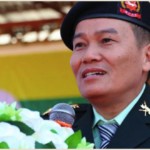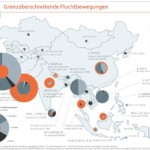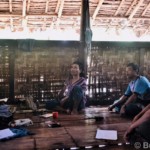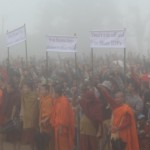Burma Link | January 30, 2019
After more than seven months’ delay, the third session of the 21st Century Panglong Conference (21CPC), taking place in July 2018, excluded discussions on contentious issues such as non-secession, self-determination, and ethnic rights. The country’s peace process has stalled over the Burma Army’s insistent demand on the Ethnic Armed organizations (EAOs) to carry out Disarmament, Demobilization, and Reintegration (DDR), which many EAOs see as an agenda of Burman racial supremacy. Throughout the peace process, the Burma Army has continued to flout provisions of the ‘Nationwide’ Ceasefire Agreement (NCA), commit gross human rights abuses particularly against ethnic civilians, and launch large-scale military attacks against EAOs and civilians.
In this second part of the exclusive interview with Burma Link, Khun Oo — the General Secretary of the Pa-O Youth Organization (PYO) — provides his insights on the current peace process and the on-the-ground situation in the Pa-O self-administered zone after the Pa-O National Liberation Organization/Pa-O National Liberation Army (PNLO/PNLA) signed the NCA in October 2015. Raising his concerns over the trend that most of the international aid flowing into Burma is top-down, inflexible and ineffective, Khun Oo calls for international donors and organizations to reconsider the designs of their funding mechanisms, to acknowledge the fundamental role of local civil society organizations and to work hand in hand with local partners with mutual recognition. He also sheds light on the problems surrounding the recent development of Burma’s largest Chinese-invested coal-fired power plant project in Tigyit, Shan State – recently resumed by the Burma Government despite public opposition. While the Burma Government’s actions have prompted renewed international interest and investment inflow into the country’s resource-rich ethnic areas, Khun Oo stresses that foreign investment in natural resource projects must be stopped until genuine peace is achieved and agreements are in place regarding the ownership and management of natural resources.
This interview is the second one in Burma Link’s “Youth Voices” series that we will be publishing until further notice. The series is meant to give more in depth understanding into the situation, concerns, and feelings of Burma’s ethnic youth and the work that ethnic youth organisations are conducting.
[/fusion_separator]‘Nationwide’ Ceasefire Agreement (NCA) and the Peace Process: “Many people don’t really trust the peace process when they have ceasefires but at the same time cease-and-fire.”
It is like half of the peace process is dead. Some people say there are deadlocks, I will also say the peace process is deadlocked. We can’t say it’s healthy because half of the peace process is already dead. For example, you can’t really walk with only half of the good body, so it’s not working. If you want to walk or you want to improve, the whole body should be healthy. If the body is half dead, you are like kind of dead people.
On the other side, the signatory groups who signed the ‘Nationwide’ Ceasefire Agreement (NCA) said something like “yes, the peace process is improving.” But, how, what, where has the peace process been improving? They replied, “be patient, we are trying our best.” That’s what the signatories to the NCA said. For those who didn’t sign
For example, they [NCA stakeholders] often said, “You should do this and that, after that we do this and that, okay?” One side said, “Okay, how we are going to do this, you hold this place and I hold this place,” but the other side opposed, saying “No, I want this area and I want to discuss with my own people; I want to discuss about this thing but not that thing.” Then one said, “No, shut up, only discuss this thing”. The EAOs often come into this situation saying, “No, I don’t believe in you; I want to jump out [from the circle of NCA], I want to jump in.” So these kinds of situation are the problems [of the implementation the NCA].
So the implementation process itself is the problem, not the agreement. How to implement [NCA] is the problem. The policy itself just has very small problems like the issue of non-secession and disarmament. So these are the current main problems of the agreement. There are too many things happening now. That’s why people think that the whole thing [peace process] is stuck. Actually the NCA would not really be stuck, if there were some good procedures. But people just couldn’t do like that [following the procedures]. That’s also a problem as there is no timeline [to implement the NCA]. Generally, the peace process is stuck right now, however, it is not in stuck for the military [Burma Army] because they have a plan. Their plan is going on in progress; but the EAOs are stuck somewhere – “Shall we [EAOs] move forward, shall we [EAOs] wait or what shall we do.” The military [Burma Army] have their own procedures and they keep going on in the peace process according to their plan. But other two actors [NCA signatory EAOs and non-signatory EAOs] are not really moving forward, they are moving backwards, backwards and backwards. So the peace process is stuck for some people, but it’s going smoothly for some people — which are the military [Burma Army]. The government also feels complex with the peace process.
In my view, I think that some people feel that they don’t get any benefits without fighting. That’s why some people want to see there is fighting, so they can take some political benefits. Not only the Burma Army’s side, but also some of armed groups as well. Fighting affects the peace process because they [Burma Army and some EAOs] break their promises and the agreements they made. Even though they agreed to a ceasefire, they still fight again. This is because they didn’t have inclusive agreements, but they signed [bilaterally] with one EAO after one EAO. They [EAOs] didn’t have a chance to talk to each other and sign the ceasefire agreements together with each other. If in fact they all signed [the NCA] jointly, it could have reduced some problems. The starting point of signing the NCA was wrong, that’s why the consequences [fighting] also happened like that. It [fighting] impacts the current peace process in Burma. Many people don’t really trust the peace process when they have ceasefires but at the same time cease-and-fire.
Situation in the Pa-O Self-administered Zone after NCA: “The benefit of signing the NCA has not really come to effect yet, but what we have gained from the NCA is that we can have meetings like Pa-O ethnic consultation meetings and issue-based meetings.”
There is no big change in Pa-O self-administered zone after signing the NCA. We cannot expect a lot because they [PNLO and Burma Government] only signed the NCA about 2-3 years ago [in October 2015]. They cannot do anything yet as they have been busy with meetings, meetings and meetings, so they cannot do the [NCA] implementation on the ground. But what they could do is that they set up military [Burma Army] and Pa-O National Liberation Organization /Pa-O National Liberation Army (PNLO/PNLA) territory areas. So, the benefit of signing the NCA has not really come to effect yet, but what we have gained from the NCA is that we can have meetings like Pa-O ethnic consultation meetings and issue-based meetings. So we [Pa-O people] have the chance to meet and talk to each other. That’s the chance that we got.
However, after that [signing the NCA], it has already been three times that fighting happened between the PNLA and the [NCA signatory] Restoration Council of Shan State (RCSS). Even though fighting happened long in the past, before the territories of NCA signatories and the military was set up, fighting had not happened in the recent past. In the year [following] signing the NCA, the RCSS came and fought with them [PNLA]. Following the fighting, the RCSS also said, “They [PNLA] came to our territory.” They have their own reasons [to justify the fighting]. There was fighting in 2018 on October 15, they [RCSS] said that fighting was started by a fake RCSS [group], they did not know whether the armed group was real or not. But the armed group is the real RCSS, they just made up another name. There was also fighting in 2016 and in 2015.
Another thing is that there is also a big gap between Pa-O ethnic group and Shan ethnic group. Pa-O fights with Shan; Shan fights with Pa-O: Some of us are also worried about the gap between the Pa-O and Shan. So, now we have a chance to talk to each other [because of the NCA] but at the same time, fear is also getting big because of the fighting between the two EAOs.
Displacement and Repatriation: “There are a lot of things to do before starting repatriation, it is not that simple. Don’t just say ‘welcome back.’”
You know the Burma Army always cracks down on the ethnic armed groups who are against them. This is how they are always trying to defeat the ethnic armed groups who are against them. Another way is that having refugees and IDPs in the country doesn’t look good from the international perspective. “If you want to die, you just die at your home, die secretly, we [Burma Government] don’t want to see it.” There are two main reasons. The first reason is that they want to control the ethnic armed groups who are against them; another thing is that the international community would see there are many IDPs inside the country. “No, we don’t fight with each other, we are making peace. There are no IDPs at all.” This is the image they want to show the world.
Actually, there are a lot of issues when we talk about [refugee and IDP] repatriation, that’s not that simple. For the IDPs to return, the first thing is that, there should be a way to sign an agreement in the NCA like how the IDPS can return safely and [how] to build their lives safely. There should be a political agreement on that paper [how the IDPs can safely return and build their lives]. Another thing is the security of the stakeholders. Let’s say, [for example], the Shan, Burmese [Burma Army], and Pa-O armed groups are active at an area, so if there is also another armed group active in that area, some problems will happen. So, they need to have the security sector reformed. They [Burma Army or EAOs] have to be taken out from that area. This issue needs to be discussed.
Another thing is the livelihood of the returned refugees or the IDPs: how they could make their livelihood safely. Livelihood means to eat and to live safely, to survive and not to die. When they come back, there is nothing left in their homeland. So they have to restart everything again and it’s not possible [without support]. They will always be impacted by their status as IDPs. We have to look after them for their livelihood, and think about how we can currently fund them; let’s say in agricultural development or [offering] some kind of support for them. We have to check that area if there is still a school, there is still a house. In our history, when the IDPs left their homeland, other people came and took all of their things [like] rice, vegetables, and onions. So when they return, there is nothing left in their homeland. So they have to restart and have struggles like “where is my money, how can I restart, where to go?” Another thing is health issue. When they relocate, they may face some kind of diseases and health issues. [They need] emergency [care] or sustainable clinics, or whatever can provide them health care. Another thing is for the young generation. Before we set up schools for the children and young people, how can we make them to feel like normal people? They have been living in fear for a long time. A lot of things have happened. So, it is not only about education as the education is going take a lot of time.
For me, I think that it’s a very huge job for the government and the armed groups to do these kinds of things [preparing for safe repatriation]. The first is political agreement; second is the armed groups’ security issue; third is the livelihood of the returned refugees or IDPs. There are a lot of things to do before repatriation and it is not that simple. Don’t just say “welcome back.” We also have to give a lot of financial support to the IDPs [and refugees].
International Support in the Peace Process and Human Rights Issues in Burma: “At the top, they show some cards but they still hide some cards there. Investing in the top level could be politically wrong, however, [investing at] the local level is very simple because of no political interest.”
Regarding the involvement of the international community in Burma’s peace process, I think that it should be depended on the country. Generally, the international community is trying to study carefully what’s happening in Burma because if they say something wrong about the situation, they also have responsibility. They have money, but they have to spend their money in a right and effective way. Also, I think currently they also have to listen to the government, which is also an issue. It’s hard for me to say if they make the right or the wrong decision as some countries make wrong decisions but some countries make right [decisions]. For the human right issues, they [international community] have not reached in Burma well enough yet. Human rights in Burma now are broken, people think that Burma is a democracy; or Aung San Suu Kyi as a democratic figure is the de-factor leader. However, when you see inside Burma, human rights do not exist at all. They cannot reach here because there are a lot of internal controls and bans for them to access [areas] in Burma. Also, there is kind of corruption and many hidden agendas that they [international community] cannot see much, so they couldn’t have really helped a lot when it comes to human rights issues in Burma. They know something is happening in Burma but they can’t really do a lot.
Generally, now when they have money, they mostly invest 70% of their money at the central level but it’s just about 25 or 30 percent for the local level. For me, what I think is if they really want to help Burma, I would like to switch the figure of the investment to the local level. That [local level] is the main foundation because when leaders at the top level are angry at each other, the money invested by the international community will be wasted; if they are happy with each other, that is okay. Otherwise, if they are not happy with each other, you [international community] have the money which can divide people among themselves . At the top, they show some cards but they still hide some cards there. Investing in the top level could be politically wrong, however, [investing at] the local level is very simple because of no political interest. So, you have to invest [more money] and trust at the lower level platforms than the top-level administration. You have to be careful with the budget and trust the situation on the ground. Not only money, but also other kind of support like technical support or the way you believe that there is democracy in Burma — something you have to be careful with.
They also need to increase more energy in improving the human rights issues in Burma. When I said they could increase more energy, I mean they can support the local youth organizations that work for human rights issues. They can support directly those who are really working at the community-level, where human rights violations are happening. The local community-based organizations (CBOs) and civil society organization (CSOs) do not have a lot of or enough support, so it would be great if they [international community] could support them directly. They have to support [on the local level] even if they don’t come [with proposals] by themselves, please just send the money. Even though they said that [providing support for] human right issues is not okay [not approved by the Burma Government and Burma Army], they could try to make another title like peace funding and use the funding for the human rights issue or whatever is needed. They have to find a way to ensure the money is arriving to the locals safely. If they have not spoken out much on the human rights issues in Burma, then maybe they can speak more. If they have already spent some money [contributing to the human rights issues in Burma], then maybe they can spend more than [the amount] in the past.
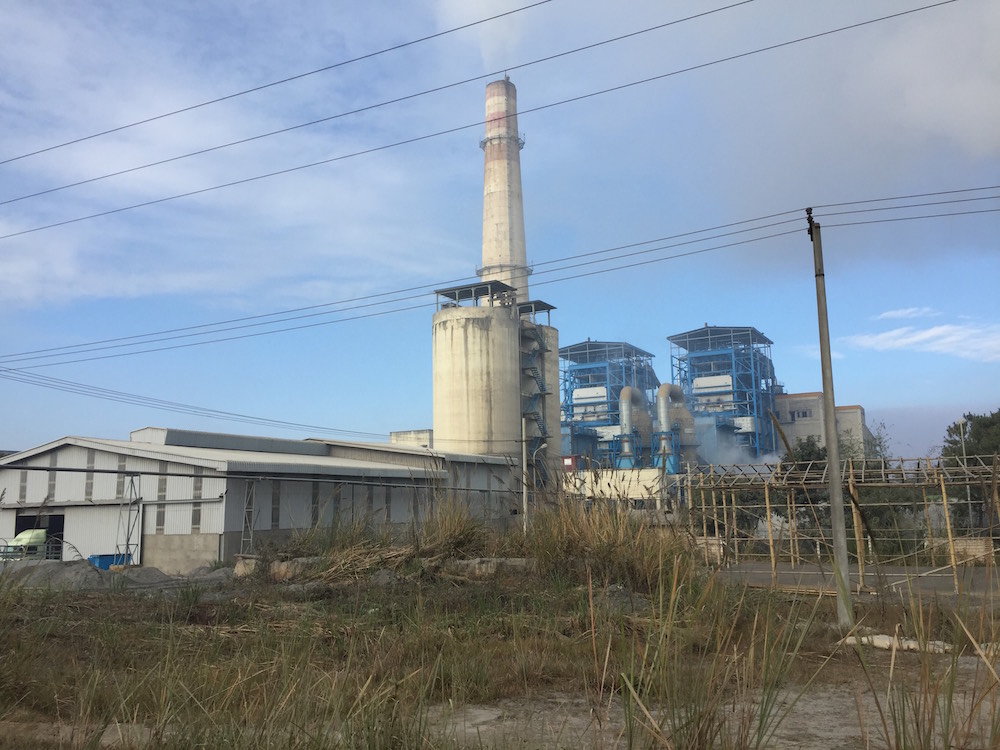
The Tigyit Coal-fire Power Plant at Tigyit Village, Pinlaung Township of Shan State has recently finished its one-year trail operation and the Burma Government has planned to resume it shortly despite the environmental and social impacts. (Photo: PYO)
Tigyit Coal-fired Power Plant Project in the Shan State: “Every stakeholder is losing.”
The Tigyit coal-fired power plant project, situated merely 12km from the iconic Shan landmark of Inle Lake, is Burma’s largest coal mine producing up to 2,000 tons of coal every day. The former military regime’s Vice-Senior General Maung Aye approved the project site in 2011, instructing the local military to confiscate over 100 acres of civilians’ farmlands without adequate compensation. A 2011 report “Poison Clouds: Lessons from Burma’s Largest coal project in Tigyit” reveals that over 400 residents from 70 houses of two villages have experienced forced displacement since the mining project began in 2003 while many continue to suffer adverse environmental, health and social impacts caused by the project. In 2014, the Tigyit coal-fired power plant was temporarily suspended reportedly due to the Chinese company Wuxi Hua Guang Electric Power Energy’s poor management. However, a year after the suspension, Burma Government granted a 22-year license to the company after it had pledged to upgrade the plant and conduct waste management procedures. Despite failing to conduct an environment impact assessment (EIA), test operations for the resumption of the plant followed, and in 2018, the Burma Government informed the local people about its decision to resume the project. In May 2018, Tigyit communities and the PYO released a joint statement opposing the planned resumption of the Tigyit coal-fired power plant and urging for an immediate stop of the project due to its severe negative impacts for local communities.
The Tigyit coal-fired power plant had been under testing for a year since 2017. So a year of testing is over now. The power plant can continue working for 20 or 30 years, it’s a decision made by the Burma Government. They will restart the generator and the project again. According to the Burma 2008 Constitution, this kind of development is decided by the Central Government. When we talk to the local administrators and the community workers, we have already urged them to suspend and stop [the Tigyit power plant], but they replied that they could not say yes or no. They said, “No, you have to talk to the President, talk to the Central Government. If they say yes, then we will say yes, but, if they say no, we will say no. Now, we are saying not [to cancel the power plant]. It’s a decision made by the Central Government clearly, that’s why.”
Of course, I am not [satisfied] with the decision by the Central Government. If they build that kind of power-plant in Naypidaw, it might be okay. Let’s build it there, and let them know how it feels [to live near the coal-fired power plant]. Operating the coal-fired power plant is making every stakeholder, including the company, the government and residents, lose. The local community face livelihood problems, health problems; the environment is being destroyed like [there is] mountain loss and agriculture loss. The technique of the company is from China, so it doesn’t really comply with the quality of coal here. They [company] have to try the coal engine again and again, and send it back to China again and again, then transfer the engine back here again. So, the company also hasn’t gotten a lot of money — they expected to generate around 100 megawatts but they only got around 20 megawatts. That’s why they couldn’t give a lot of money to the government. The government also cannot get any tax. So every stakeholder is losing. However, politically the Burma Government wants to show like “this is the decision of the Central Government, they [people] have to listen. Whether it’s good or bad, we don’t care.” The government just wants to show like they have power and authority.
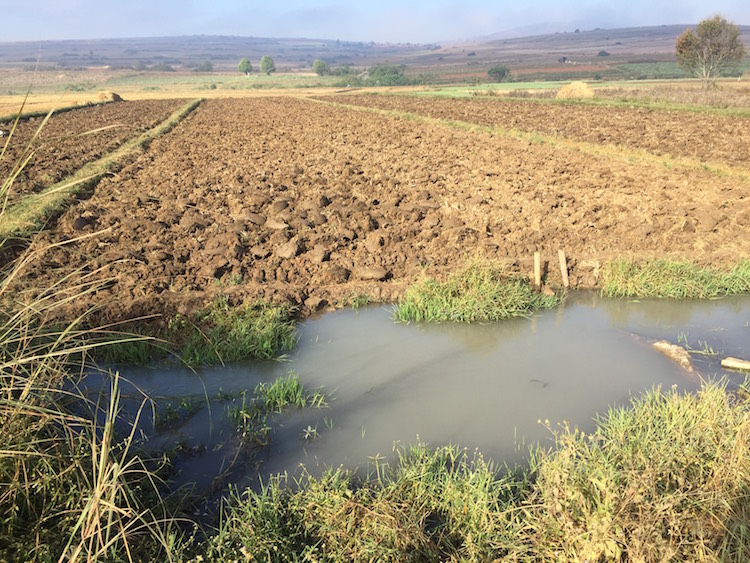
Coal ashes – the waste products from the Tigyit Coal-fired Power Plant has been mismanaged and release to the nearby river, contaminating the agricultural farm and threatening the health of almost 12,000 people living within a 5-mile radius of the project. (Photo: PYO)
Impacts of the Tigyit Coal-fired Power Plant: “When it comes to investment and development, they [Burma Government and foreign investors] take the civilians’ land without giving money or they only give a little compensation which is not enough.”
The lives of people have been affected. The health issue is a very [important] main problem, especially for the pregnant women, young children and old people. They suffer from health problems and there are unusual health issues happening. [For example,] three people died without being diagnosed with exact reasons and even the doctor himself also had a neck problem and said, “I don’t know, please check what’s happening with this problem.” Also, when pregnant women give birth, the weight of their children is not really good. So health problem is the main issue. Another thing that is that in the past, there were beautiful mountains, but now the landscape is affected and there is a very big hole [in the ground]. They haven’t restored the environment that has been destroyed. For one pagoda, the government once said, “We will repair this pagoda because the pagoda is broken,” but there are also a lot of [other] pagodas broken down and they didn’t repair any.
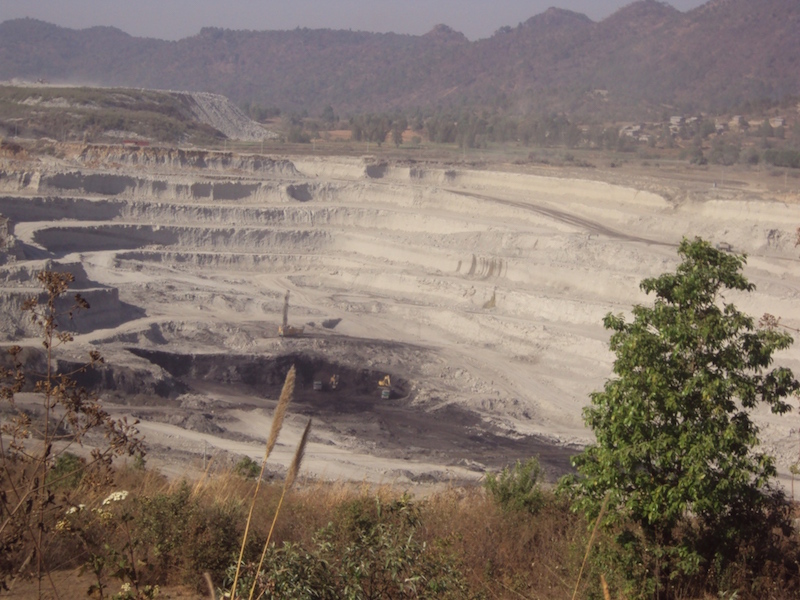
The mining area in Tigyit Village is an open cast pit, covering an area of over 500 acres that continues to expand. Smaller amounts of coal are also extracted by an underground tunnel system, which involves four feet square holes under farmlands. Since the start of mining in 2002, dynamite explosions have caused cracks and shaking of nearby houses and local pagodas. (Photo: PYO)
Other than that, when it comes to investment and development, they [Burma Government and foreign companies] take the civilians’ land without giving money or they only give a little compensation which is not enough. They extend the [project land] area more than what they had requested, so people face problems with their agricultural activities. The coal ashes from the power plant also fall into the river, which people use for daily cleaning and farming. The agricultural farm [land] doesn’t look good. When the farmers sell their crops in the markets in other areas, the market [people] will say, “This food is from Tigyit area, that’s why we don’t buy it unless you sell it for a very low price.” In the past, the prices of agricultural products from the Tigyit area were great, but now everyone knows the products are from a polluted area.
Even though Pa-O people don’t feel okay with the Tigyit coal-fired plant, they don’t dare to speak out because they are afraid of the authorities and think that, “We can’t say anything, we can’t do [anything] about this thing, that’s why it’s better to be silent.”
Message to the International Community: “I think they have to listen carefully [to voices and situation from] the ground before they make a decision to help or invest in Burma.”
Ethnic states in Burma are rich in natural resources and biodiversity, and yet are among the most poorly developed areas of the country due to the unsustainable extraction and unjust sharing of the natural resource revenues. For decades, the Burma Army has launched military offensives in ethnic areas and asserted its control over indigenous ethnic territories, reaping significant benefits from extraction and exploitation of the resources. Despite the ongoing armed confrontations, the Burma Government continues to invite foreign large-scale investment projects at the expense of local ethnic communities. As the 2008 Constitution places natural resource ownership, control, and management fully in the hands of the central government, investment decisions regarding these projects are extremely centralized and most planning is executed by the Burma Government and foreign entities. While the projects have gained huge revenues for the Burma Army and the central government, local populations receive no substantial benefits and instead suffer from environmental destruction, forced displacement, human rights abuses, and loss of livelihoods. For more information on the central resource control and lack of local involvement or approval, read the Burma Environmental Working Group’s (BEWG)’s 2017 report “Resource Federalism: A Roadmap for Decentralized Governance of Burma’s natural heritage.”
I want to tell the international community please not to invest in land or natural resources projects. “You can invest in technology projects, marketing projects or educational projects — we seem [end up] okay with those projects, [although] maybe not totally okay with these kinds of projects. However, do not invest in land or natural resources projects. Currently, please don’t come [to invest] — if you come, you are wrong even though you are right in your intention. You are wrong to be in Burma, maybe [you are] right [to be] in China, right in India. If you come to Burma to invest in natural resources [projects], you are very wrong. Now even though you are the best [investor] in the world, you are wrong to come to invest [in natural resources projects] in this place.” Even though they [international investors] will show the best technology and the best way in investment, it’s still wrong here.
If you come to invest here, we will fight with each other here. You got something, I got nothing and then we will fight again and again. Then they [Burma Army and EAOs] will go to the forest and fight again. Finally when the root cause of the fighting is found out — which is because there are [resources like] jade on the ground and only the central government take the resources, and nothing is left for the ethnic states. That’s why they [Burma Army and EAOs] will fight again and again. That’s why we don’t want to see corruption here, and we should know how we are going to share the budget and the money, who owns these resources and those resources. Resource management and control and revenue sharing are very important. You can do this kind of investment after politically and constitutionally peace is set up in Burma. At that time you can come and negotiate with the government and people for investment. So if all these things are set up and in place, everyone will be happy, then you [international investors] can come. At that time you will be a little bit right too. But now, “Please don’t do this kind of stuff.”
I think they [international community] have to listen carefully [to voices and situation from] the ground before they make a decision to help or invest in Burma. I also worry that when they give something, actually they also want to get something back. For example, some countries said that, “I’ll help you, but I want to get this thing from your country.” I know there is always giving and taking but this should only happen when the country comes to peace. Be firm about peace, do not think about other investments like “I give you this money and then you give me the permit to take out this thing” or “give me the permit to take out the gas.” Playing cards and making trade-offs is not really good. That’s why I think that if you really want to help Burma in building peace, then just focus on how the peace is being progressed and don’t expect a lot of other things. So, that’s my main concern. After peace is stable in Burma, [when] there is a democratic system in Burma, at that time you are also welcomed to come to Burma to do what [ever] kind of investment or kinds of things you plan to do. Now if you do that [investment on land and natural resources], you will also lose. I don’t want to make them sad by saying they are doing wrong, [but] that’s why [I say it].
Message to the Burma Government and Burma Army: “If other people see the situation that you [Burma Government and Burma Army] can do something while having negotiation, they [EAOs] think that they also can take up the natural resources.”
Also for the parts of the Burma Government and the Burma Army, we are now talking about the peace process and having peace dialogues, but at the same time they carry out this kind of investment. It is not a good way. If you talk, you have to only focus on talking first. After you talk, you can do what you want to do according to the agreement after discussion and negotiation among the stakeholders. It’s not like you are talking and you are doing at the same time. If other people see the situation and that you [Burma Government and Burma Army] are doing something while having negotiations, they [EAOs] think that they also can take up the natural resources. This is because they will think that “you can make money, so I can also make money.”
For me, firstly we [Burma Government, Burma Army and EAOs] have to talk to each other clearly. After that, we maybe discuss how we are going to frame and structure our economic vision, how we can share our power, how we share the natural resources and how we maintain this kind of thing and those kinds of things. We will hold our responsibility if there is clear power division on the paper. If the constitution would also somehow be better than now, we could also discuss about issues of investment in natural resources.
Message to the people in Burma: “We can’t wait to get peace because people are dying. That’s why we have to work on the ground to seek justice and equality.”
Another thing is related to Burma, the NCA, the peace process and the current parliament. We cannot invest a lot of hope in that [path]. We also have to think any alternative ways to monitor [the peace process] or to have a back-up [plan] when the NCA and the parliament don’t work — the parliament and the NCA that are not working currently. They are stuck, and the rights of people are still being violated. We can’t wait to get peace because people are dying. That’s why we have to work on the ground to seek justice and equality. We can’t wait until peace comes by itself and then say, “I will give something to help others.” No, we can’t do that because we have to have food and eat even though peace is not here yet today. So you can’t wait for peace to have food. So, do what’s working for peace, invest in youth and do not harm anyone. Do some good.
============
END NOTE: The interview was conducted with Khun Oo on October 18, 2018, marking the World Youth Day for Democracy. The interview was conducted in English and has subsequently been edited for clarity and flow whilst retaining the original language as much as possible.



